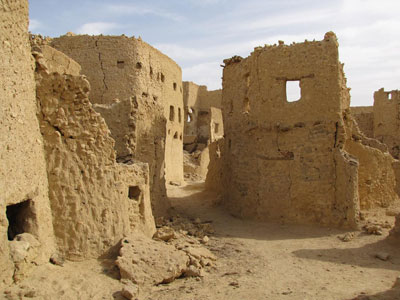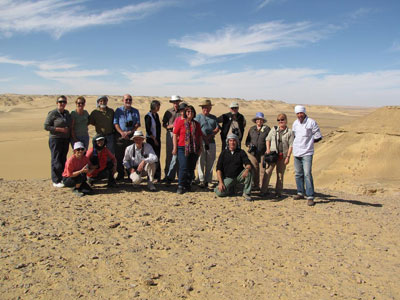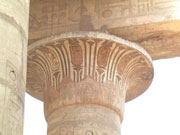TOUR NEWS -
WESTERN DESERT OASES TOUR OF EGYPT FEBRUARY 2009
WESTERN DESERT OASES TOUR OF EGYPT FEBRUARY 2009
The Western Desert Oases Tour of Egypt for February 2009 took place from 3rd to 22nd February. The tour group included: Kate Gosford, Brenda Wass, John Burke, Claire Bousfield, Shyam Lee-Joe, Kerry and Janet Peadon, Chris and Kim Shephard, Peter and Erica Wallace, Warwick Barnard and Carol Rowe, and Stewart and Irene MacKenzie. The tour leader was Michael Birrell and the Egyptian guide was Mohamed Aziz. The tour was followed by a 10-day camping expedition to the Gilf Kebir region of SW Egypt.
The tour began with an early morning arrival in Cairo and a transfer to our hotel in the downtown area of the city. In the afternoon we visited the Cairo Museum with its world famous collection of artefacts. We explored the main part of the collection looking mainly at artefacts from the Oases and later part of Egyptian history.
 |
 |
Alexandria Harbour |
The Old City in Siwa |
In the morning we travelled north by bus to Alexandria. After checking into our hotel, the Metropole, we visited the new Museum of Alexandria, home to a fascinating collection of sculpture from the later periods of Egyptian history. Finds included artefacts from the harbour and lighthouse. The following morning we explored the remarkable remains of the Kom es-Shuqqafa Necropolis which was built in the Roman Period. The tombs are grouped around a central rotunda and are famous for their relief sculpture which includes the funerary god Anubis dressed as a Roman Centurion. Later on we saw the Kom ed-Dikka Roman Theatre and the new Library, a wonder of 21st Century architecture, which houses a fascinating collection of artefacts from the site. After lunch we explored the evocative Fort Qaitbey, built upon the ruins of the famous lighthouse of Alexandria. In the evening we had a very pleasant fish dinner overlooking the harbour.
In the morning we left Alexandria and headed west by bus along the Mediterranean coast of Egypt. We stopped to see the Ptolemaic Temple of Osiris at Taposiris Magna and the fascinating tomb in the shape of the Alexandrian Lighthouse. Later in the day we saw the World War II battle site of El Alamein and the fascinating War Museum with its memorabilia of the battle. A walk through the Commonwealth War Cemetery was poignant for those members of the group who had relatives who fought at Alamein. In the afternoon we continued our journey along the coast before heading inland to Siwa Oasis in the afternoon. A superb sunset marked our descent into the Oasis.
In Siwa we explored the picturesque remains of the 13th Century mudbrick fortress of Shali with its labyrinth of multi-storey buildings. The view from the summit of the hill is superb. We also saw the Gebel Mawta 'Hill of the Dead', a fascinating Late Period cemetery with painted tombs. After lunch we explored the romantic remains of the settlement of Aghurmi where Alexander the Great famously consulted the Oracle of Amun and was confirmed as the son of Zeus-Ammon. A few of us had a swim in the warm sulphur baths at 'Cleopatra's Pool'.
 |
 |
The Great Sand Sea near Siwa Oasis |
The stunning White Desert of Farafra Oasis |
The following day we went by 4-wheel drive into the deep desert west of the Oasis to explore the dramatic Great Sand Sea - here the sand dunes spread for hundreds of kilometres to the south and west. We enjoyed the vast dunes and saw some fossils. A few of us had a swim in the Bir Wahed hot spa bath, located in a small desert palm grove. The next day we left Siwa Oasis and headed east across the vast open desert to Bahariya Oasis. We stopped briefly to see the dramatic landscape of Areg Oasis and explored some tombs - we later had lunch and Bedouin tea at the pools of Nuwamisa Oasis, located on the edge of the Great Sand Sea. The trip took us through dramatic desert landscapes on our 340 km trip to Bahariya Oasis. In the evening we checked into our hotel in Bawiti, the main town of the oasis.
Bahariya Oasis is a depression in the Sahara SW of Cairo which is rich in historical remains. We had a look at the remains of the 'Temple of Alexander' and visited the little 26th Dynasty Chapels of Ain el-Muftella. We also saw the local Museum which houses the famous 'Golden Mummies' which were discovered in the 1990's, and explored the interesting painted tombs of Zed-amun-ef-ankh and Bannentiu.
The next morning we travelled 90 km south of Bahariya Oasis to Farafra Oasis, stopping en route to see the spectacular Black Desert. Chris, Kim and I climbed to the top of a desert plateau for a superb view over the open sands. We then headed by 4-wheel drive into the stunning White Desert. This is an otherworldly region of wind-carved white rock formations. We had a perfect sunset over the expansive rock formations before heading to our tent camp for French Champaign and a wonderful dinner. Songs around the campfire were accompanied by the sight of falling stars and John and Chris's well informed descriptions of the various constellations.
In the morning we explored some of the natural beauty of Farafra Oasis and the surrounding desert before heading to our hotel in Farafra Oasis. We took a walk in some of the palm gardens and visited some of the local attractions like the Badr Museum Gallery. The following day we headed by bus to Dakhleh Oasis, a distance of 250 km. The road passes through scenic desert country with dramatic landscapes and cliffs. We had some lunch in the medieval city of Qasr and explored the Old City which still preserves something of the old way of life once common in the desert. This includes winding narrow streets and houses with carved wooden doors. The escarpment behind the city is spectacular! In the evening we checked into our hotel in Mut. In Dakhleh Oasis we saw the town of Mut and its surrounds (and were invited in for tea), the small Ethnographic Museum, and the picturesque ruins of the Roman temple of Deir el-Haggar. A relaxing hot spa in the local sulphur springs was the prefect end of the day.
In the eastern side of the oasis we stopped to see the visible remains of Ismant el-Kharba, Roman Kellis, where I had been involved in excavations in the early 1990s. We then headed east to the unspoiled village of Balat which retains much of its medieval character - the cool enclosed streets give a wonderful impression of an earlier age. We visited the fascinating mastaba tombs of the Old Kingdom at Qilat ed-Dabba and went for a walk in the village of Bashendi where we saw the Roman period Tomb of Kitnes. In the afternoon we headed 190km east to Kharga Oasis, stopping on the way to have lunch near some ancient rock-art sites and to see the fascinating barkhan-dunes which encroach upon the main road.
In Kharga Oasis we visited the Archaeological Museum which preserves artefacts from the Oases of the western desert, including some of the painted funerary goods and inscribed wooden boards which I found at Ismant el-Kharab in Dakhleh. In Kharga we attempted to see the Temple of Amun at Hibis, but it is currently under restoration and despite attempts to get official clearance we could only see it from the road. Instead we explored a nearby Christian monastery. We had a very pleasant lunch in the nearby palm groves and explored the Christian tombs at el-Bagawat. Dating from the 4th Century AD, there are 263 mudbrick tombs at the site, many of which contain painting of Biblical themes. We then had a look at the Roman Temple of Nadura located on a hill to the north of the town and went for a swim in the local hot spring, located in an attractive palm garden.
 |
 |
The Western Desert tour group |
The temple at Qasr el-Ghueita |
Our last day together as a group was spent looking at the wonderful antiquities along part of the Darb el-Arba'en, the '40 Day Track', an ancient trade route which leads down into the Sudan. In the morning we visited the superb Late Period temple of Qasr el-Ghueita which is located in an impressive Roman fortress. Nearby we saw the picturesque Qasr ez-Zayyan Temple which lies half buried in sand. In the afternoon we headed to the southern end of Kharga Oasis. Here, in the stark landscape of the Sahara, are the romantic ruins of Qasr el-Dush, a frontier fort and temple at the southern frontier of the Roman Empire.
The following day a few members of the tour group (Kerry, Janet, Chris, Kim, Stewart, Irene and Claire) headed down to Luxor where they had some time to explore before catching a flight back to Cairo. They were affectionately known as the 'deserters' since they were heading back to Australia while the rest of us were the 'desert-ers'. We were heading into largely unknown and untrammelled territory: a 10-day camping expedition to explore the remote Gilf Kebir plateau in the SW corner of Egypt...
Michael Birrell

